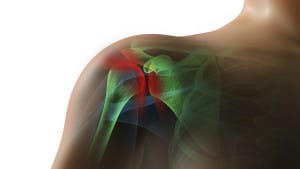Sudden Shoulder Pain: Lisa’s Story and Recovery
When a busy working mom suddenly develops debilitating shoulder pain, diagnosis and pain relief is desired – quickly! This is what happened to Lisa, a social worker and mother of two who lives in Arizona with her husband.
When the pain started in Lisa’s left shoulder, it hindered her daily activities. She could not lift her arm to put on a shirt and it was very painful to turn the steering wheel in her car. “Any movement felt like bone scraping on bone,” said Lisa.
Lisa, originally from Illinois, but an Arizonan since 1997, knew about Dr. Brian Gruber through a friend at work who is an occupational therapist. When she met with Dr. Gruber, she said she was impressed with how educated he was. “He understood what the problem was immediately,” said Lisa.
Dr. Gruber diagnosed Lisa with calcific tendonitis, a condition where calcium deposits develop in the shoulder. The diagnosis was confirmed with an x-ray of Lisa’s shoulder, where the calcium deposits were visible. Dr. Gruber discussed a non-surgical treatment option with Lisa called needle aspiration to remove the calcium deposits, which she opted to have performed.
The result of the procedure gave Lisa the outcome she was after – relief from the pain and increased shoulder mobility. In addition to being pleased with her results, Lisa added, “Dr. Gruber is a compassionate doctor. He made the procedure as comfortable as possible and decreased my anxiety about the procedure by explaining everything in detail before and during the procedure.”
She said that the entire team at Integrated Orthopedics displays compassion, excellent communication with patients and demonstrates expertise in their field. “I would definitely recommend Dr. Gruber and the team at Integrated Orthopedics,” said Lisa.
More about Needle Aspiration and Calcium Deposits in the Shoulder
Lisa’s condition, called calcific tendonitis, is relatively common. It has a peak age of onset of 40 and affects women more commonly than men. It affects the rotator cuff tendons, most typically the supraspinatus tendon of the rotator cuff.
When an inflammatory reaction in the shoulder occurs in relation to the calcium within the rotator cuff tendon, it becomes symptomatic. The inflammatory reaction rather than the presence of the calcium is actually what causes symptoms to start.
Calcific tendonitis is diagnosed by an x-ray, which will show the calcium deposits. There are two approaches to treatment. And, the one that will work for a patient will depend on whether the calcium deposits are “soft” or “hard.” The first procedure, which Lisa received, is non-surgical and uses needle aspiration. The second option is surgery to remove the calcium deposits. Unfortunately, there is no way to know if the calcium deposits are soft or hard prior to needling or surgery.
Since Lisa’s deposits where soft, the needle aspiration procedure worked for her. Dr. Gruber was able to insert the needle under ultrasound guidance and aspirate the soft calcium deposits.
Statistics show that needle aspiration tends to be successful in about 50 percent of calcific tendonitis cases. After a needle aspiration procedure, minor discomfort and soreness can be expected in the shoulder. Many patients, like Lisa, make a full recovery and return to their normal activities of daily living.
Learn more about Integrated Orthopedics, an orthopedic practice offering innovative and evidence-based orthopedics, sports medicine and physical therapy services to patients in Phoenix, Arizona and its surrounding area.

